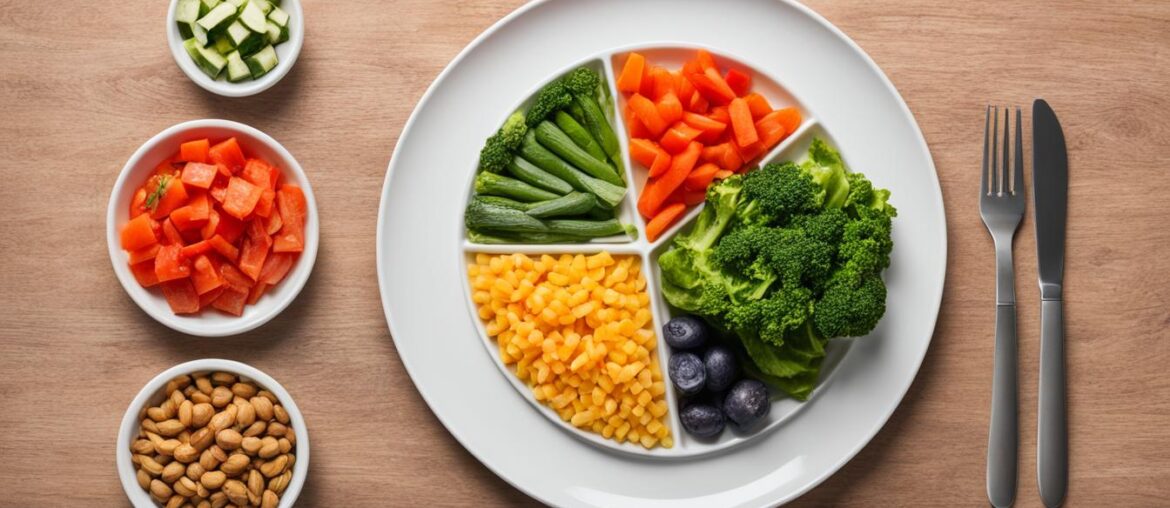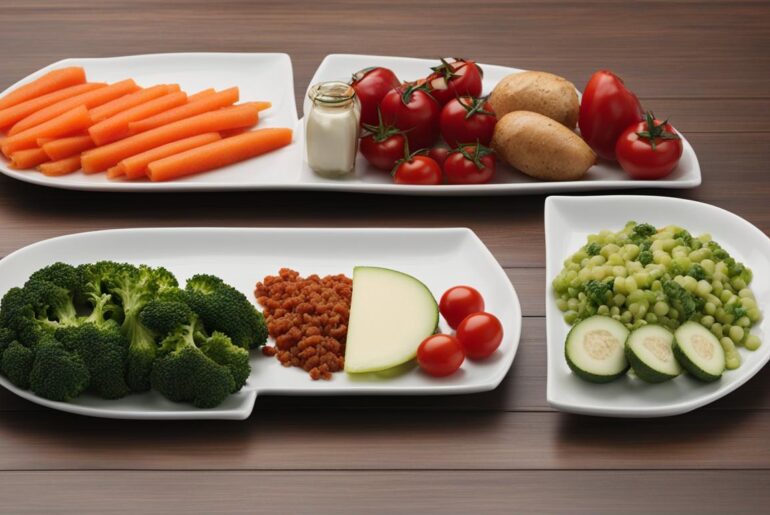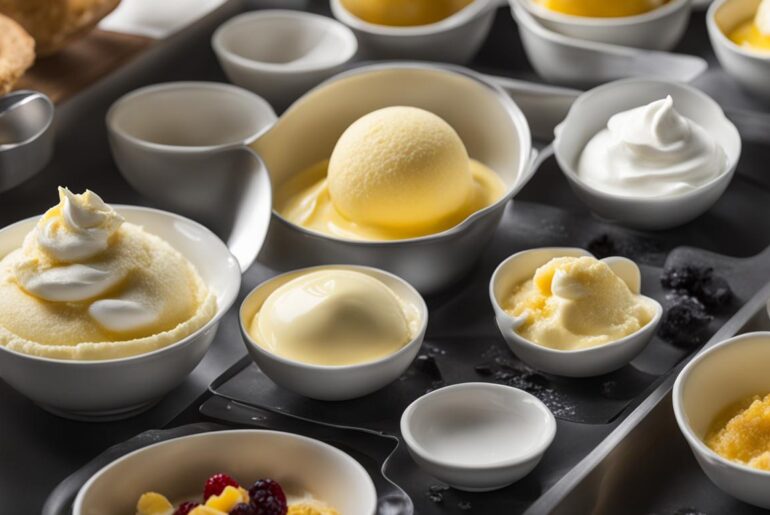As a professional copywriting journalist, I understand the importance of portion control in low-carb diets. Controlling portion sizes is not only crucial for managing calorie intake but also for optimizing weight loss and striking a balance between macronutrients. By implementing effective portion control strategies, individuals can achieve and maintain their weight management goals while still enjoying the benefits of a low-carb eating plan (see my post here).
When it comes to low-carb portion control, there are several practical tips that can make a significant difference. Using smaller plates and measuring cups can help create a visual illusion of a generous serving while still keeping portion sizes in check. Being selective with seconds and choosing nutrient-dense foods can also aid in portion control on low-carb diets.
It is important to understand that portion control goes beyond just restriction; it is about making conscious choices that support overall health and well-being. By mastering portion control in low-carb diets, individuals can not only manage their weight but also ensure they meet their nutritional requirements (check out my post on mastering portion control here).
Key Takeaways:
- Controlling portion sizes is essential for success in low-carb diets and weight management.
- Practical tips such as using smaller plates and measuring cups can aid in portion control.
- Portion control is about making conscious choices that support overall health and well-being.
- Understanding the importance of portion control is crucial in achieving and maintaining weight management goals.
- By mastering portion control in low-carb diets, individuals can strike a balance between macronutrients and meet their nutritional requirements.
The Importance of Portion Control
Portion control plays a vital role in weight management and overall nutrition. It is an effective strategy to prevent overeating, support weight management goals, and develop a healthier relationship with food. By practicing portion control, individuals can prevent unnecessary weight gain, create balanced meals, and enhance satiety and digestion.
One of the key benefits of portion control is its impact on weight management (check this post out). By controlling portion sizes, individuals can manage their calorie intake and create a calorie deficit, which is essential for weight loss. When we consume larger portions than our body needs, we tend to consume excess calories, which can lead to weight gain over time. Portion control helps us align our food intake with our energy needs, promoting gradual and sustainable weight loss.
In addition to weight management, portion control also plays a crucial role in meeting our nutritional requirements. By practicing portion control, we can ensure a balanced intake of macronutrients (carbohydrates, proteins, and fats) and micronutrients (vitamins, minerals, and antioxidants). This balanced approach to eating supports overall health and well-being.
Developing a healthy relationship with food is another valuable outcome of practicing portion control. It helps us become more mindful eaters, paying attention to our hunger and fullness cues. By focusing on appropriate portion sizes, we can avoid mindless eating and prevent the tendency to overindulge. Portion control promotes a sense of satisfaction after meals and eliminates the guilt that often accompanies overeating.
Understanding the science behind portion control and its impact on weight management is crucial for success in achieving our health and wellness goals.
By incorporating portion control into our daily lives, we can make significant strides towards achieving and maintaining a healthy weight. It empowers us to make mindful food choices, create balanced and nutritious meals, and enjoy a healthier relationship with food.
| Benefits of Portion Control: | Role of Portion Control in Weight Management: | Portion Control and Nutrition: |
|---|---|---|
| – Prevents overeating | – Effective strategy for weight loss | – Ensures balanced macronutrient and micronutrient intake |
| – Supports weight management goals | – Helps create a calorie deficit | – Promotes overall health and well-being |
| – Develops a healthier relationship with food | – Aligns food intake with energy needs | – Encourages mindful eating |
Understanding the importance of portion control is the first step towards adopting healthier eating habits. It empowers us to take control of our portions, make mindful food choices, and achieve our weight management goals.
Stay tuned for Section 3, where we will discuss practical tips for portion control at home.
Practical Tips for Portion Control at Home
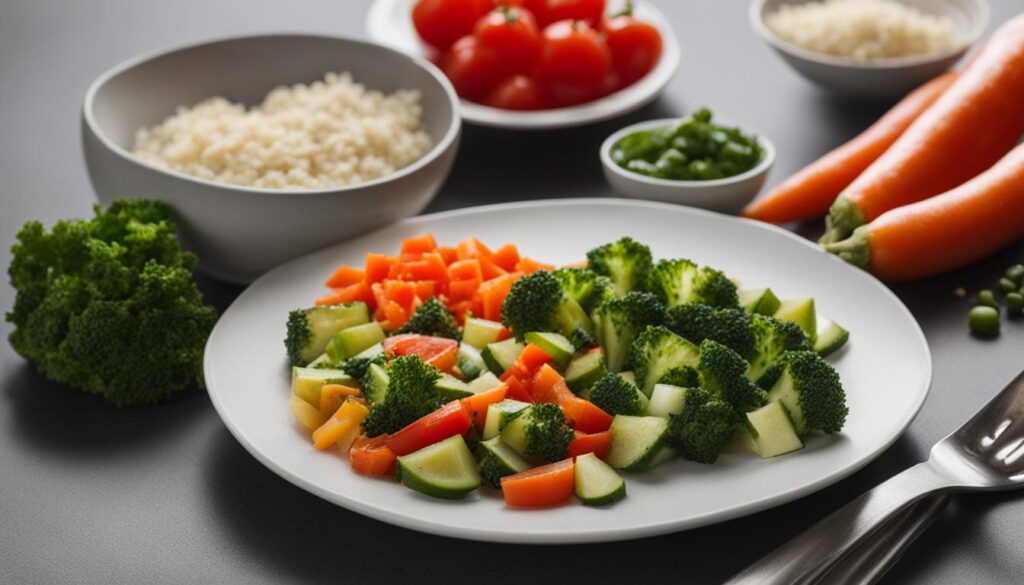
Implementing portion control at home can be challenging, but there are practical tips and tools that can help you stay on track. By incorporating these strategies into your daily routine, you can maintain healthy portion sizes and achieve your weight management goals.
1. Use Smaller Plates and Bowls
Believe it or not, the size of your dinnerware can influence your perception of portion sizes. By using smaller plates and bowls, you create an illusion of a more substantial meal with smaller portions. This can help you feel satisfied and prevent overeating.
2. Measure and Weigh Ingredients
Accurate measurement is key when it comes to portion control. Use measuring cups and food scales to ensure you are consuming the appropriate amounts of each ingredient. This will help you stay within your desired calorie range and avoid unintentional overeating.
3. Pre-portion Snacks and Meals
One of the easiest ways to control portion sizes is by pre-portioning your snacks and meals. By dividing them into individual servings, you can avoid mindless grazing and ensure that you’re consuming appropriate amounts of food. This technique is especially helpful when it comes to calorie-dense snacks like nuts or chips.
4. Utilize Portion Control Plates and Containers
Portion control plates and containers are handy tools that can aid in visualizing and maintaining appropriate portion sizes. These specially designed products have compartments for different food groups, making it easier for you to create balanced meals. They serve as a helpful guide when it comes to portioning carbohydrates, protein, and vegetables.
5. Plan Meals in Advance
Planning your meals in advance allows you to take control of your portion sizes. By creating a weekly meal plan, you can ensure that you’re incorporating a balance of nutrients and portioning your meals appropriately. This not only helps with portion control but also makes grocery shopping and meal preparation more efficient.
6. Stay Hydrated
Drinking water before meals can help promote portion control. Not only does it help hydrate your body, but it can also create a feeling of fullness, making you less likely to overeat. Aim to drink a glass of water about 30 minutes before your meals to support portion control.
Implementing these practical tips can make portion control at home more manageable and effective. Remember, the goal is to find a balance that works for you and allows you to maintain a healthy lifestyle.
The Difference Between Portion Size and Serving Size
When it comes to portion control, it is essential to understand the difference between portion size and serving size. These terms are often used interchangeably, but they have distinct meanings and implications for managing your diet and nutrition.
Serving size refers to a standardized amount of food recommended by food groups or typically consumed in a single sitting.
“Serving size” is the amount of food customarily consumed per eating occasion by individuals who are 14 years of age or older and who do not have specific dietary requirements. It is used to calculate the nutrient content of a specific amount (portion) of food.
On the other hand, portion size is subjective and varies depending on an individual’s appetite, preferences, and eating habits. It is the amount of food that a person chooses to consume at a given time.
Understanding the difference between serving size and portion size is crucial for practicing portion control effectively. While serving sizes provide a standardized guideline, portion sizes should be tailored to meet your specific dietary needs and goals.
Food labels can be a valuable resource when it comes to determining serving sizes and making informed decisions about portion control. These labels provide information on recommended serving sizes based on the food product’s nutritional content.
| Component | Amount per serving |
|---|---|
| Calories | 140 |
| Total fat | 5g |
| Protein | 10g |
| Carbohydrates | 18g |
| Sodium | 200mg |
By carefully reading food labels and comparing them to your personal goals, you can make informed choices about portion sizes and ensure that you are consuming the appropriate amount of nutrients.
In addition to relying on food labels, using measuring cups and food scales can help you accurately assess portion sizes (see my post here). These tools can provide a tangible representation of serving sizes and assist you in maintaining portion control.
Remember, portion control is not about strict deprivation or restricting yourself from enjoying your favorite foods. It is about finding a balance that allows you to meet your nutritional needs while promoting overall health and well-being.
Developing a mindful eating approach and being aware of portion sizes can help you make smarter choices, manage your calorie intake, and achieve your health and weight management goals.
Portion Control Tools
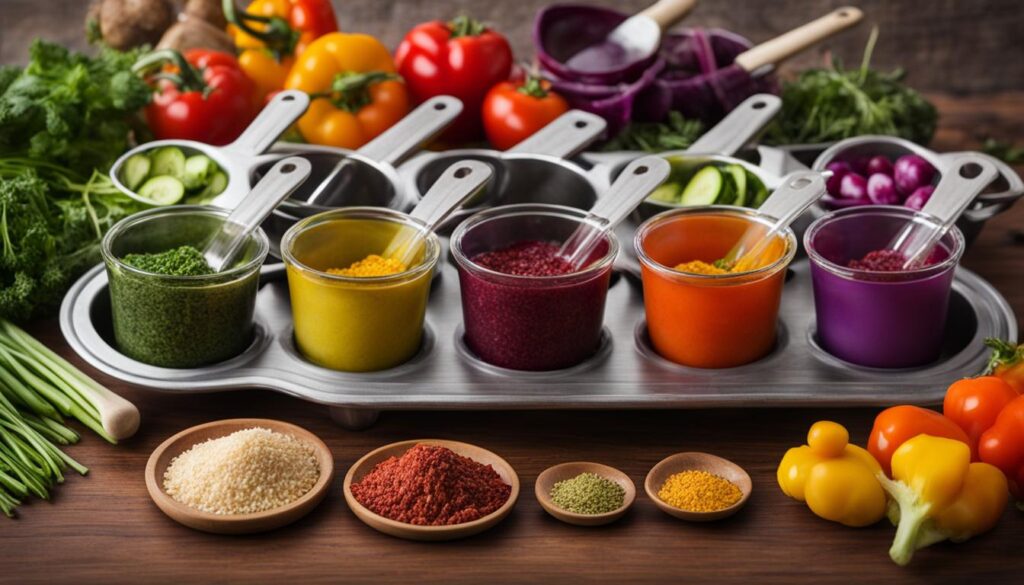
When it comes to maintaining portion control, having the right tools can make all the difference. There are several options available that can help individuals visualize and manage their portion sizes effectively. Here are some popular portion control tools:
1. Portion Control Plates
Portion control plates are specially designed to help individuals create balanced meals by dividing them into sections for different food groups. These plates guide users to fill each section with the appropriate amount of proteins, carbohydrates, and vegetables. By using portion control plates, individuals can easily visualize and maintain portion sizes according to their dietary needs (check out my post on portion control plates here).
2. Portion Control Containers
Portion control containers are convenient tools that allow individuals to pre-portion their meals and snacks in advance. These containers are designed to hold specific amounts of food per food group, making it easy to manage portion sizes for meal prep or on-the-go. With portion control containers, individuals can stay on track with their portion control goals and avoid overeating.
3. Portion Control Apps
In this digital age, there are various portion control apps available that can assist individuals in managing their calorie intake and portion sizes. These apps provide guidance, tracking, and sometimes even personalized meal plans to help users make informed decisions about their portion sizes. Some popular portion control apps include MyFitnessPal, Lose It!, and Lifesum.
Combining these portion control tools with mindful eating practices can lead to successful weight management and a healthier lifestyle (check this post out). They can help individuals stay accountable, make smarter food choices, and achieve their portion control goals.
| Portion Control Tools | Description |
|---|---|
| Portion Control Plates | Divided into sections for different food groups |
| Portion Control Containers | Designed to hold specific amounts of food per food group |
| Portion Control Apps | Provide guidance and tracking for portion sizes |
Overcoming Common Challenges in Portion Control
Portion control can be challenging, especially with the prevalence of larger portion sizes and snacking habits. One of the main challenges is portion distortion, which refers to the phenomenon of increased portion sizes that make it difficult to gauge appropriate servings. This can lead to consuming more calories than needed.
Eating directly from packages and large containers also contributes to overeating. The mindless act of snacking from these sources can lead to a lack of awareness regarding the actual amount of food consumed.
To overcome these challenges and promote successful portion control, it is essential to implement effective strategies. Here are some helpful tips:
- Measure food portions: Use measuring cups or a food scale to ensure accuracy in portion sizes. This allows for better control over calorie intake and prevents overconsumption.
- Use smaller dinnerware: A smaller plate or bowl creates an optical illusion of a larger meal, making it psychologically satisfying even with smaller portions.
- Plan meals in advance: Planning meals ahead of time enables better control over portion sizes and helps avoid impulsive eating or reaching for unhealthy snacks.
By implementing these strategies, individuals can take control of their portion sizes and make healthier choices. Maintaining awareness of portion sizes and snacking habits is key to successful portion control and overall weight management.
Key Takeaways:
– Portion control can be challenging due to larger portion sizes and snacking habits.
– Portion distortion makes it difficult to gauge appropriate serving sizes.
– Eating directly from packages and large containers contributes to overeating.
– Helpful strategies include measuring food portions, using smaller dinnerware, and planning meals in advance (see my post here).
– Taking control of portion sizes and snacking habits is essential for successful portion control and weight management.
Conclusion
Mastering portion control is crucial for achieving success in low-carb diets and overall weight management. By adopting practical tips and using portion control tools, individuals can effectively manage their calorie intake, prevent overeating, and create balanced meals. Understanding the difference between portion size and serving size, as well as overcoming common challenges, lays the foundation for long-term success in achieving weight management goals.
By embracing portion control as a lifestyle habit, individuals can experience the benefits of improved health and well-being. Adopting portion control habits allows for better control over food portions, ensuring that calorie intake aligns with nutritional needs (see my post here). This commitment enhances weight management efforts and promotes a healthier relationship with food.
Achieving weight management goals is not only about restricting food intake but also about making mindful choices and establishing sustainable habits. Portion control success comes from a combination of awareness, portion control tools, and consistent practice. By implementing portion control techniques, individuals can take charge of their eating habits and make positive changes that contribute to a healthier and happier life.

